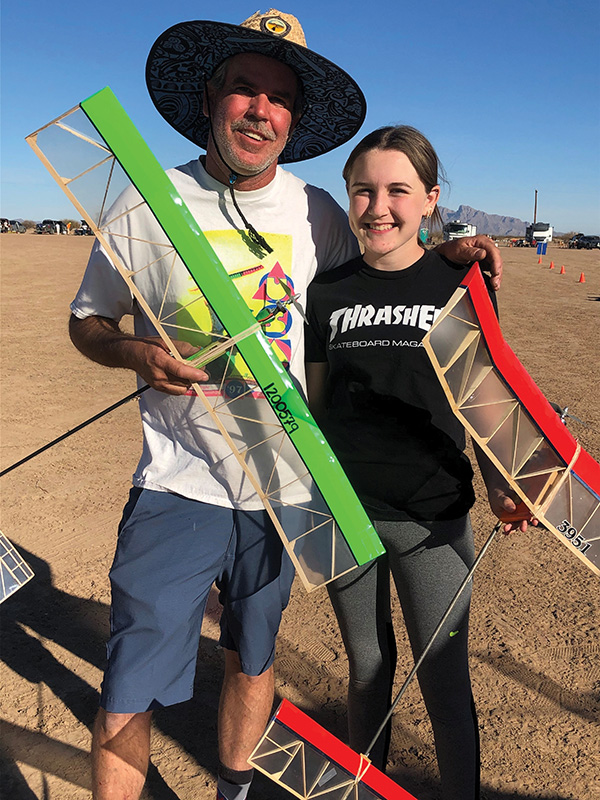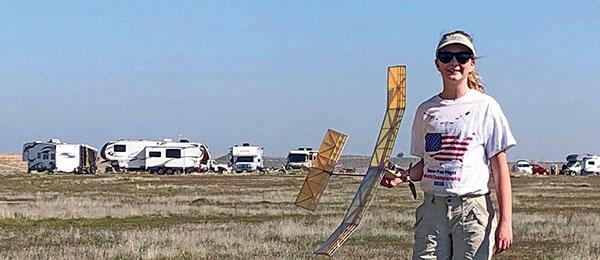Written by Don DeLoach
A record-holding, four-event design
As seen in the June 2021 issue of Model Aviation.
Image

Order Plans from AMA Plans Service
Image
Image

Document
Document

Image

Construction
The 222-E is a straightforward build, even for a novice, so there is no need for step-by-step instructions. I offer a laser-cut short kit for $35 postpaid, which saves a lot of time and effort. The most important consideration is that you avoid unintentional warps and misalignment. That’s because these models climb rapidly, and a fast-climbing FF model that is not carefully aligned can crash quickly! The biggest causes of E-36 crashes are wing warps and improper rudder offset. Triplecheck each before your first flights. The fin should start out dead straight and the wing flat on all panels except for the right inner panel, which should have a touch (3/32 inch) of washin.Covering
One-third to 1/2mm Mylar and Doculam iron-on plastics are all acceptable. A slightly heavier covering that I like is Polyspan, which has the added advantage of greater torsional stiffness, as well as excellent puncture resistance. George Morris, of Eloy, Arizona, is the current AMA record holder in Adult F1S, A, and B Electric. George wrote of his A Electric record attempt in the National Free Flight Society’s (NFFS) Free Flight Digest, November-December 2019: "On November 16, 2019, at Eloy, Arizona, I started flying at 8 a.m. The weather was overcast with light wind at 3 mph. Allan (Mecham), Wade (Lloyd), and Robert (Donnelly) timed for me. Weather, as far as lift goes, was soft. There was some light lift—not really going up, but no sink. This airplane pretty much goes straight up. "I never flew a 10-second flight; the timer only goes to an 8-second motor run. Three of those flights had no problems. The first 11 5-second flights were no problem. There was no sink. Then came some sink. [The dethermalizer (DT) went off] about 20 feet above the ground. After that I made sure there was lift before launching. I was tired, got hot, then had a brain fart on the last flight and bad launch. My time was 95 seconds." The follow-up feat three Sundays later, at the Arizona Championships, was even more impressive: 41 maxes for the AMA B Electric record. In a period of three weeks, George’s 222-E scored 64 total maxes en route to two AMA records—a feat that is unlikely to be repeated.E-36 Motors
The HobbyKing HXM-2730 3,000 Kv (Kv = rpm per volt) motor is no longer sold, but many other comparable motors are. Some are slightly more powerful and even a little lighter in weight. All are in the 26- to 34-gram weight range. Generally, any drone racing motor in the 2205/2206 class and in the Kv range of 2,600 to 3,000, paired with a 6 × 6E APC propeller, is close in wattage output to the HXM.Image

ESCs
The larger 2205/2206 motors draw more amps, so a robust 20- to 25-amp ESC is preferable. You can take your chances with lighter 11- to 20-amp ESCs if you want, but don’t run the motor longer than 10 seconds or these ESCs might fail. At least one top E-36 flier uses lightweight Cobra 11-amp ESCs on 2205 Cobra motors without problems.Motor Mounts and Tailbooms
You can mount the motor the traditional way, with balsa sheets and a plywood firewall, but a $19 upgrade is the machined, aluminum mount sold by Texas Timers. The mount fits all motors commonly used in the E-36. It also fits the tapered, 32.5-inch carbon-fiber tubes in common use, such as the Avia Skinny UL, Skinny SUL, B-Tweeny, and the Sky Shark 2PT and 3PT. The Texas Timers mount is lightweight, quick, easy to install, and extremely strong.Timers
E-36 models need electronic timers to regulate the motor and activate the DT. The two most commonly used in the US are from Starlink-Flitetech and Texas Timers. The Starlink-Flitetech version is the simplest of the two, and is a bit less expensive than the Texas, but it has only fixed flight times. For approximately $15 more, the Texas timer features an adjustment switch for both motor run time and a DT. Both offer a plug-in option for a radio-controlled DT (or remote DT) receiver, which enables the flier to push a button and offer DT on command. This is a useful feature for a fast-moving model such as an E-36.Flight Trimming
E-36 models are fast in the climb and require careful consideration to prevent mishaps. Most importantly, your model must be perfectly aligned and unintentional warps must be removed before attempting any powered flights. Tilt your stabilizer for right glide turn by setting the stabilizer level with the right main wing panel. Start by setting the center of gravity (CG) at 75% to 78% and ensuring that you have 3° of left (yes, left) thrust offset. Next, test-glide the model several times with a firm push. You should see the nose come up slightly when you do this; if not, add incidence by gradually raising the trailing edge of the stabilizer. This slight nose-up tendency is critical; it is the only way you know if the model has enough pitch stability to be safe in the climb.Image

Image

Image

Image











Comments
C17
C17 flying .
Add new comment